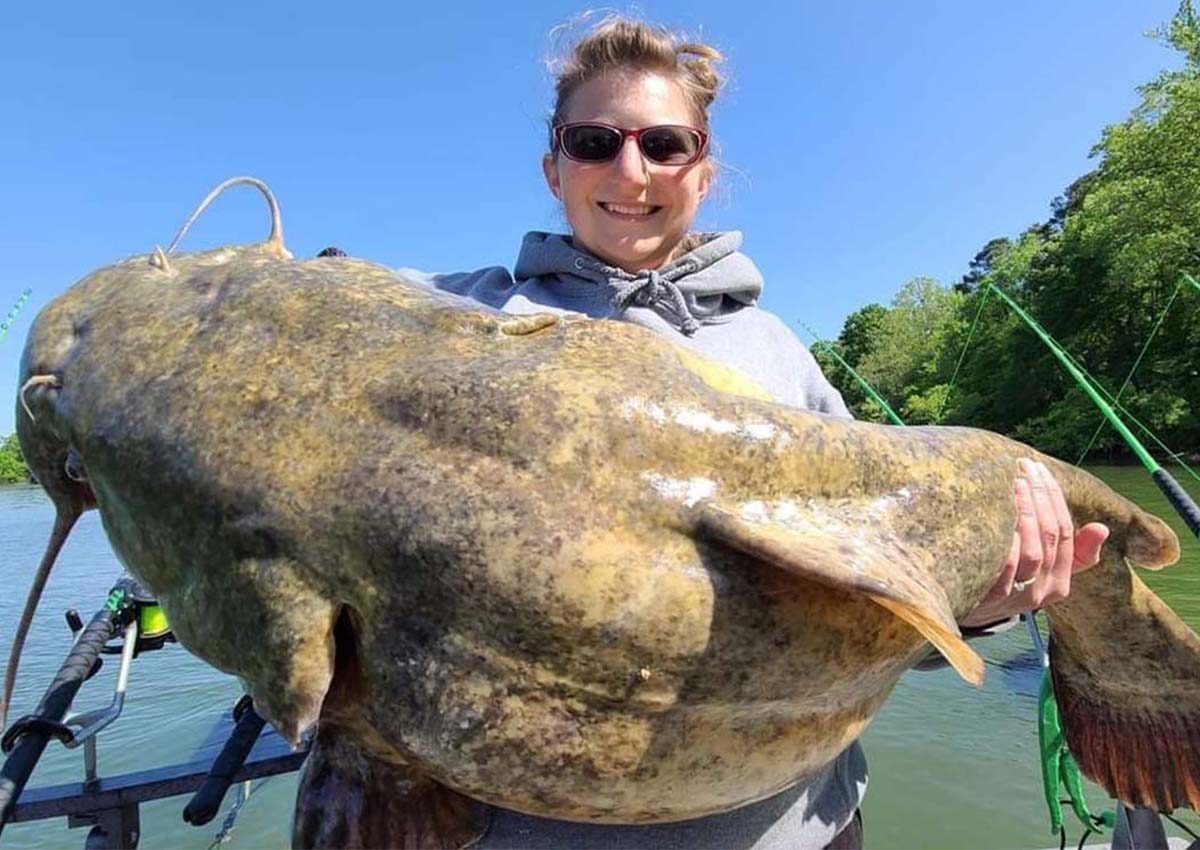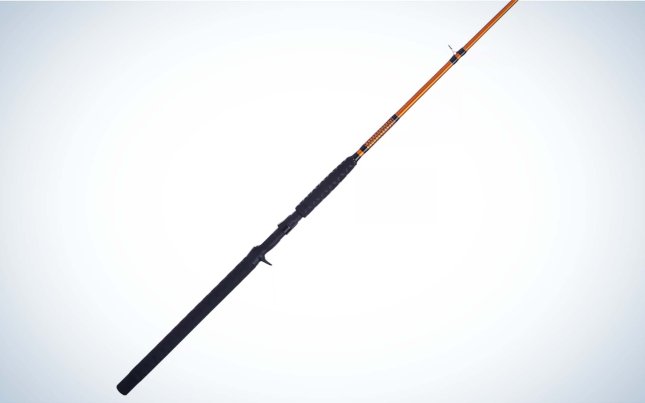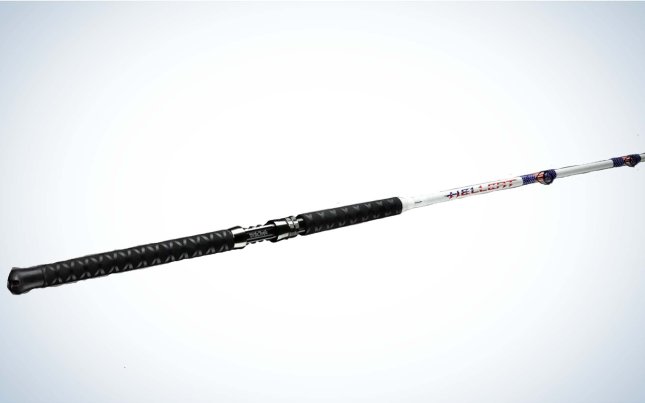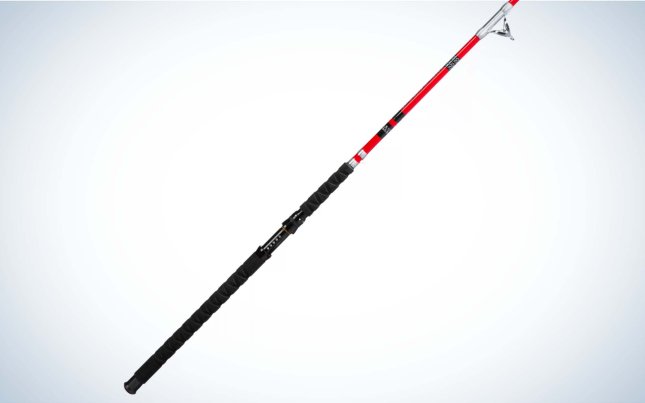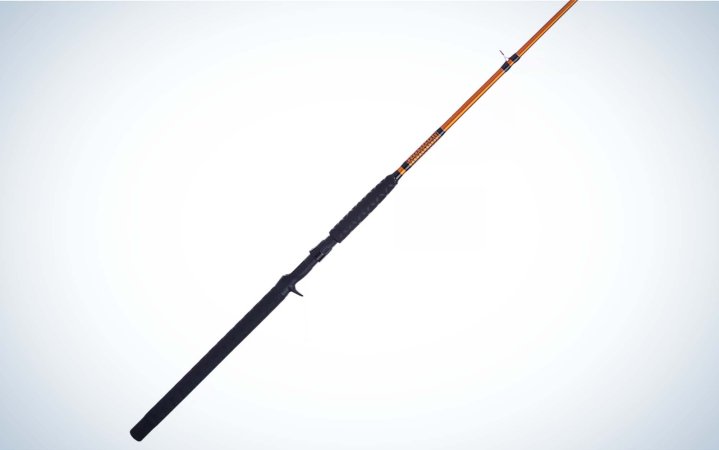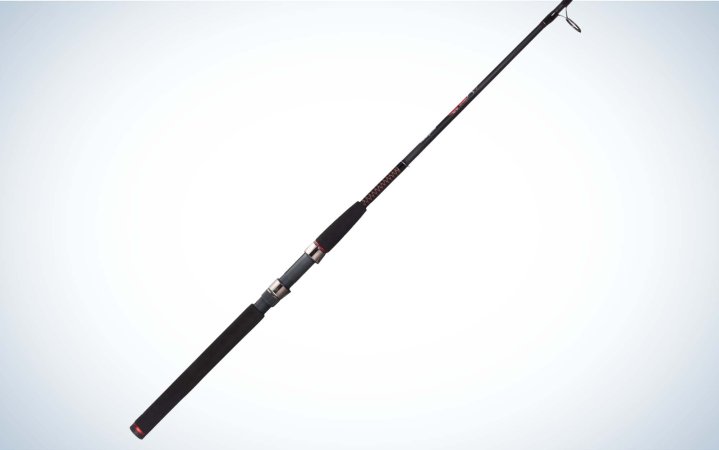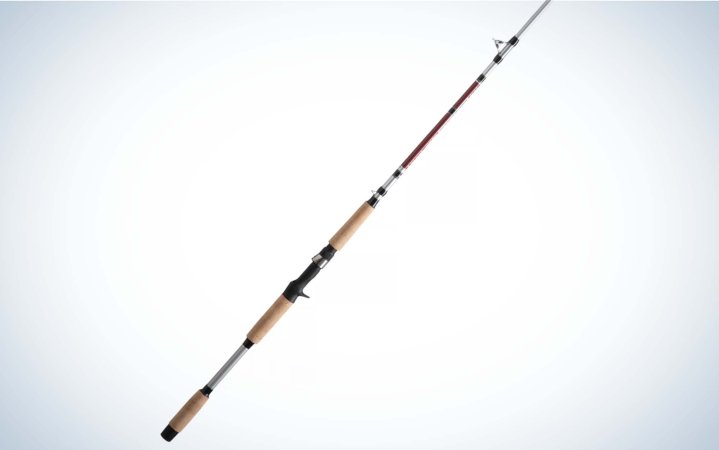We may earn revenue from the products available on this page and participate in affiliate programs. Learn More ›
Whether you’re pursuing feisty bullheads, aggressive channels, bully blues, or brutish flatheads, you’ll need a catfish rod that’s up to the task. Some anglers want rods that are limber and long, with more action so they can play a fish. Others want shorter stout rods for leverage to quickly get a fish to the boat or bank. Rod, reel, line, and other components need to work in concert to help you land a catfish efficiently. Catfish, especially big ones, surge and roll, and bury around cover. And If you just slap a reel on the first cheap rod you find at your local hardware store, those bucks you save might cost you the fish of a lifetime.
To help you find the best catfish rods, I interviewed fishing guides who pay the bills with monster cats to find out which ones excel no matter where you plan to fish.
- Best Value: Shakespeare Ugly Stik Catfish Special
- Best for Drifting: Shakespeare Ugly Stik
- Best for Bumping Bottom: B’n’M Poles Bumping Rod
- Best for Big Catfish: Catch the Fever Hellcat
- Best for Kids: B’n’M Silver Cat
Best Value: Shakespeare Ugly Stik Catfish Special
Best Value
Shakespeare Ugly Stik Catfish Special
Pros
- Budget-friendly
- Fully rubberized handles
- Durable
Cons
- Could use more options with heavy action
Key Features
- Ugly Stik clear tip
- Graphite-fiberglass blank
- One-piece stainless steel guides
- Rod Length: 7-, 8-, 9-, 10-, and 12-feet
Why It Made the Cut
A great price and durability make the Ugly Stik a superb value for catfishing.
Product Description
Shakespeare’s legendary Ugly Stik fishing rods have proven themselves time and again for a wide variety of species. They’re tough enough to withstand boat slams, cooler smashes in the truck bed, inattentive kids (and adults), and battles with big fish. The latest iteration for whisker fish anglers—the Ugly Stik Catfish Special—comes in spinning and casting models in lengths from 7-12 feet. They’re rated for 10-40-pound-test and are designed with medium-heavy power on moderate action rods. That’s a good middle-of-the-road combination for a value priced rod that punches above its weight.
Along with the rod’s guts—thin woven sheets of graphite and fiberglass—special touches and good looks add even more panache. It might seem like catfish anglers only care about stinky baits and big fish, but stylish rods are an added bonus. Shakespeare also has a 7-year warranty, which is a heck of a deal for a $60 rod.
Best for Drifting: Shakespeare Ugly Stik
Best for Drifting
Shakespeare Ugly Stik
Pros
- Durable
- Spinning and casting models
- Budget-friendly
Cons
- Limited options for lengths
Key Features
- Variety of rod lengths
- Clear tip
- EVA foam handles that work in wet conditions
- Medium-heavy actions throughout series
- 7-year warranty
Why It Made the Cut
Affordable, tough, and widely available, the Ugly Stick rods are one of Capt. Richard Simms’ favorites when he’s drifting the Tennessee river for catfish.
Product Description
Capt. Richard Simms with Scenic City Fishing in Chattanooga typically employs two primary tactics for his Tennessee River catfishing trips: drifting with the current while using light spinning tackle, and “bumping bottom” in deeper water with heavier tackle. For the former, Simms strongly recommends the Shakespeare Ugly Stik line of spinning and casting rods. He uses both and prefers them for clients, because they’re durable and easy to work even if they land a monster.
“You don’t know your clients’ abilities,” he says. “I always practice patience over power. The Ugly Stik rods, especially the 7-foot spinning rods, have a relatively light action. I preach to clients to keep the rod tip up and let the ‘bend be your friend’ while they’re fighting a fish.”

The Ugly Stik rods come in 7- and 8-foot lengths and medium-heavy action for casting and spinning. Additional options would be a plus, but for just $50 these are affordable workhorses. Guides love them, clients won’t (typically) break them, and they work. So, whether you’re taking out a new angler or want something that can endure a beating, the Ugly Stik can handle it, which is why Capt. Simms has been using them for decades.
“I have some Ugly Stik rods that are over 20 years old,” he says. “Many of them are different lengths and actions with the original guides, and I still use them.”
Best for Bumping Bottom: B’n’M Poles Bumping Rod
Best for Bumping Bottom
B’n’M Poles Bumping Rod
Pros
- Durable
- Cork handles are comfortable to hold
- Stylish white color
Cons
- Limited rod, action options
Key Features
- Fast action
- Rod Length: 7 feet, 6 inches
- Handles 25-50-pound-test
Why It Made the Cut
For big baits, weights, and catfish, this Bumping Rod from B’n’M takes it all in stride.
Product Description
Drifting light baits, such as cut chicken breasts (it works), on light tackle is fun. But when Capt. Richard Simms needs to go deeper, he prefers bigger gear. Simms will upsize his rod, line, weight, and bait to drift or anchor while bumping the bottom for bigger catfish. He and his clients catch everything from 15-pounders to 65-plus brutes. That’s why he opts for a B’n’M Poles Bumping Rod to get the job done.
“Drift fishing in deeper water with heavier tackle with a suspended bait off the bottom, or bottom-bumping, is a great tactic,” Simms says. “The Bumping Rod has a heavy backbone and good tip, and it’s a good all-around rod. When you’re bumping bottom, you want something that has some sensitivity but still has the ability to get a big one to the net.”
For Simms, the Bumping Rod has just enough sensitivity and plenty of backbone for plucking giant river cats off the bottom.
Best for Big Catfish: Catch the Fever Hellcat
Best for Big Catfish
Catch the Fever Hellcat
Pros
- Sensitive
- Reel seats won’t allow reels to walk
- Vivid colors easy to see at night
Cons
- Only one rod length
Key Features
- Power Action: Medium-extra heavy
- Rod Length: 7 feet, 6 inches
- Color Options: Patriotic, green, orange, and pink
Why It Made the Cut
Justin Conner and Tabitha Linville, The Catfishing Duo, rely on the Hellcat rods when they’re guiding for big flatheads and blue cats in deep water.
Product Description
Justin Conner and Tabitha Linville, The Catfishing Duo, guide regularly in West Virginia on the Ohio and Kanawha rivers for flathead and blue catfish. They’ve caught catfish up to 65 pounds, and Linville says the Hellcat rods from Catch the Fever are the perfect size for big flatties and blues.
“In spring the flatheads don’t bite as frequently and have a softer bite instead of really going for the bait hard, so we opt for the medium-heavy,” she says. “That gives us more detection with the bite, because it has a more sensitive tip.”

During the summer months, Conner and Linville do a lot of night fishing. And they both prefer the bright green rod (and line) option, because it’s easy to see bites in the dark.
The Hellcat series also comes in medium, medium-heavy, heavy and extra-heavy actions, capable of handling 10-pound-test for small cats to 80-pound-test for monsters.
“We use the heavy action in summer, but it depends mostly on the current,” Linville says. “There’s more backbone to those heavy rods and we’ll use them if we have clients who aren’t as familiar with holding the rods. The tips are sensitive, which definitely helps. So you’ll know it’s a flathead because the rod tip goes down real slow, but a blue just smokes it.”
Best for Kids: B’n’M Silver Cat
Best for Kids
B’n’M Silver Cat
Pros
- Glow-in-the-dark tip helps detect bites at night
- Versatile medium action
- Handles line sizes from 10- to 20-pound test
Cons
- Would like more options in the casting line
Key Features
- Rod Length: 7 feet, 6 inches
- 100 percent fiberglass blanks
- Ceramic guide inserts
- Graphite reel seat
Why It Made the Cut
These durable rods can handle the abuse that kids or novice anglers can impose on them.
Product Description
Over the past 30 years Billy Blakely has caught or helped catch countless catfish at Reelfoot Lake. This stump-filled whisker fish dream in northwest Tennessee holds fields of lily pads and water that’s deep enough to harbor large cats through the winter. Blakley’s go-to rod for fishing Reelfoot is the B’n’M Silver Cat series, which he prefers to use with kids or new anglers, who, at least from his experience, can be rough on rods.
“I’ve had people with a wide range of fishing abilities over the years,” Blakely says. “We use flat bottom aluminum boats, and while we take care of our gear they do get banged around a bit. I’ve used the Silver Cat series for quite a while and they’ve always held up.”
Blakely noted that the price-to-performance ratio of the Silver Cat is one reason he keeps using them. And just because the Silver Cats are some of the best catfish rods for kids or new anglers doesn’t mean they aren’t for seasoned fishermen either. These rods have enough backbone for big cats, so if you hang a 40-pounder, you can get it in, Blakely says.
How to Choose a Catfish Rod
Catfish are found all around the world. You’ll find them in almost any water: clear, dirty, hot, cold, swift rivers or placid lakes, farm ponds, and small creeks. Some anglers believe that locating them is the toughest part. But once they’re hooked, the fight isn’t easy either. That’s why it’s important to have the right rod for the job.

Budget
The great thing about most catfish rods is that they’re quite affordable. Most cost between $50 and $100, and if you’re really keen on something specific you can pay more for a custom one.
Rod Action
Are you targeting small- to average-sized fish in a farm pond or around boat docks on the lake? A medium-heavy spinning rod will do the job. If you’re going after large catfish, you’ll need more backbone that heavy-action rods provide.
Handle Length
When you land a fish, especially a big one, you might want a longer handle that you can tuck under your arm for leverage while you’re reeling. Of course, if you’re targeting farm ponds or smaller cats, this won’t be as big of an issue.
FAQs
For years, graphite, fiberglass, or a combination of both have been the staple materials for catfish rods. Graphite is more sensitive and lighter, which helps you detect more bites, and they’re more comfortable to hold and cast, too. However, graphite is more fragile. Fiberglass rods—usually E-Glass or S-Glass—aren’t nearly as sensitive, but they’re more durable.
The bait you should use for catfish depends on the species and target size. If you’re in a farm pond or small creek with smaller fish, consider using nightcrawlers, chicken livers, or some kind of stinkbait.
On bigger waters for larger blues and channels, cut shad works great. Fresh shad is best. The bloodier, oilier and guttier, the better. Cut into chunks or fillets. Use the gut sack by itself or on a hook with a fillet. If you use the head, step on it a little to get the juices running.
For big flatheads, cut bait is an option but live bait—bluegills or shad—is better. Clip a fin so the bait appears wounded and drop either of those into a flathead’s lair. Be sure to check state regulations for using live bait.
You want to carefully remove a hook from a catfish because they have spiny fins, and they’re especially sharp. Using a fish gripper, like a Boga Grip or Berkley Big Game Lip Grip can help you control the catfish while you’re handling it. Extra long, needle-nose pliers are my go-to for removing hooks from catfish.
Final Thoughts
If you’re trying to put more catfish in the cooler, you’ll want the best catfish rods to get the job done. Just make sure you match your rod to the species and style of fishing you prefer.
Methodology
I’ve fished for more than 40 years for catfish and other species on large and small waters with friends, family, and guides. For this review, I compiled my own experience and tips from fishing guides to make these selections. These guides rely on equipment that can withstand hundreds of tough fishing days (and nights) every year. Consider their suggestions when you decide to upgrade your catfish rig.
